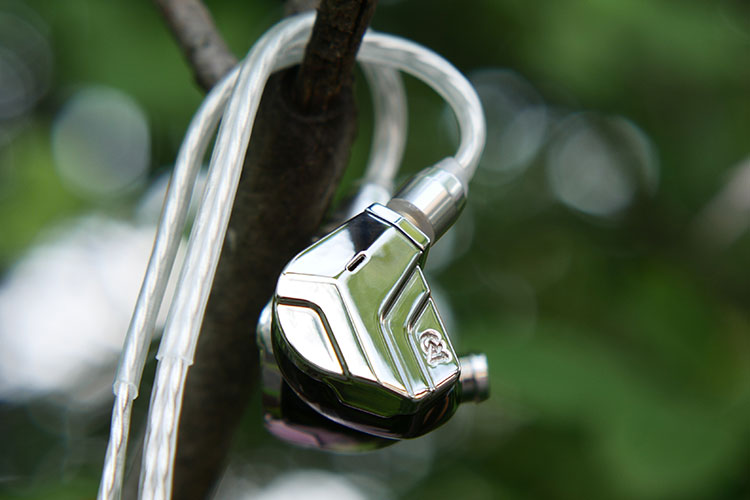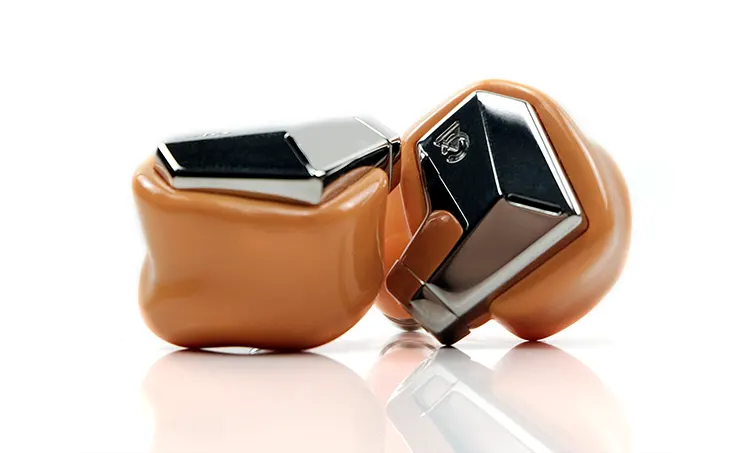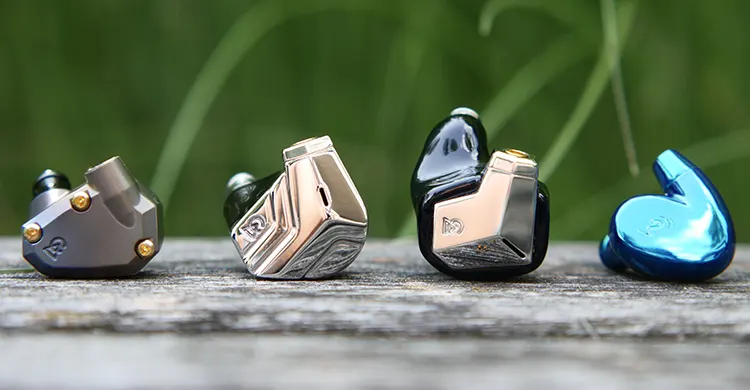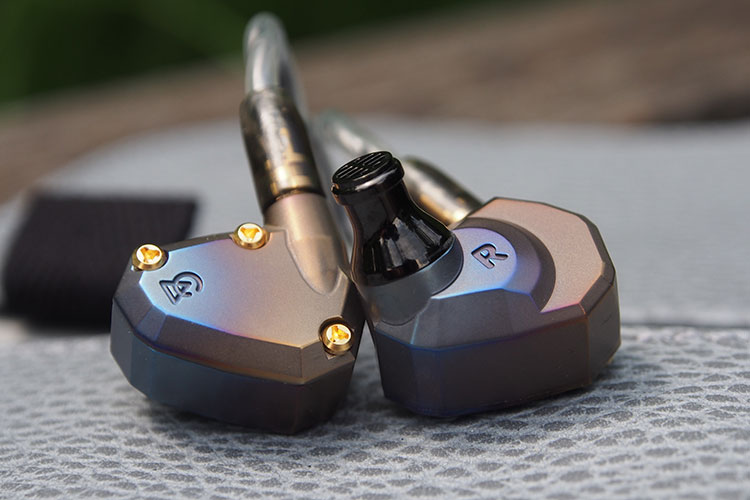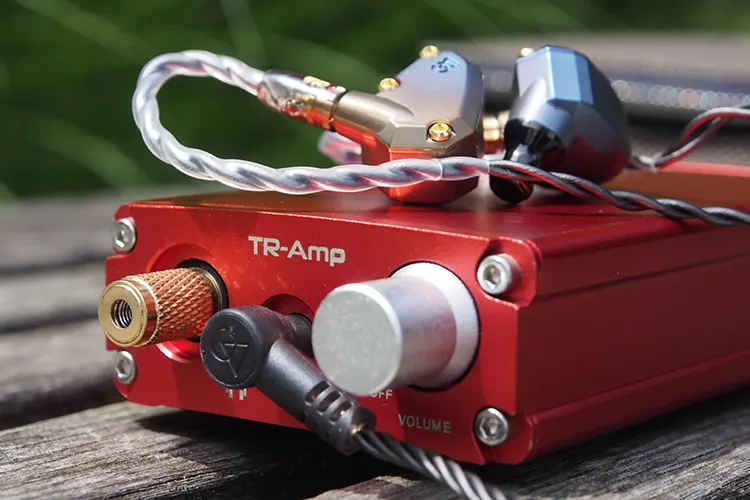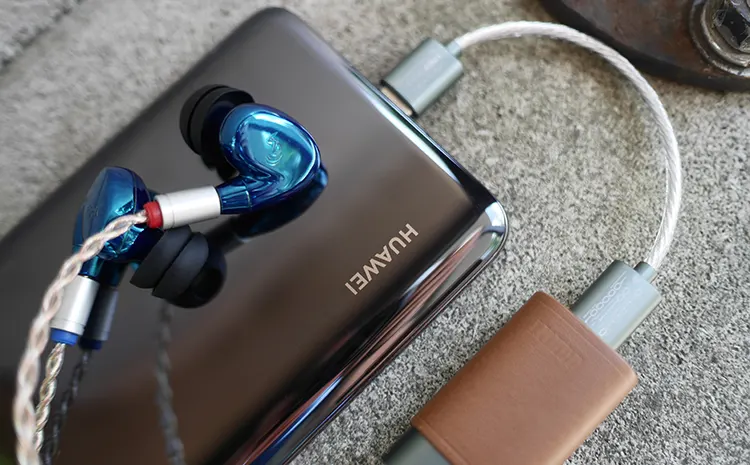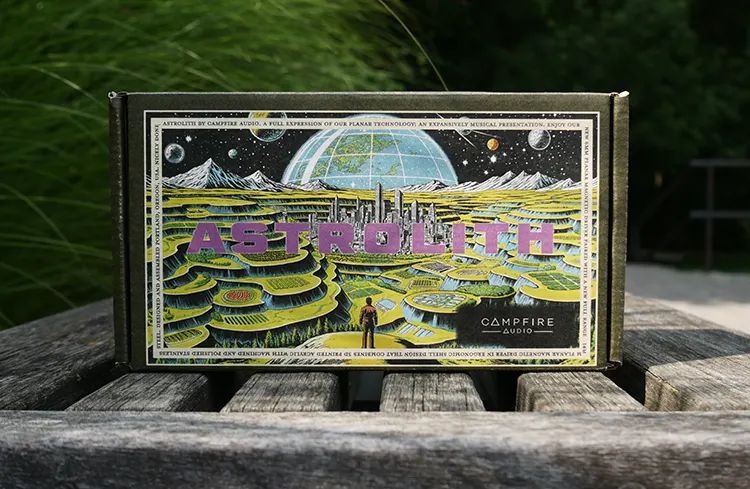Select Comparisons
Campfire Audio Supermoon
Technical
Both Astrolith and Supermoon contain planar magnetic drivers. While the Supermoon makes do with a single, large 14.2mm driver, the Astrolith kicks things up a notch with two planar drivers, one 6mm and one 14.2mm
While they both have stainless steel nozzles and backplates with 3D-printed acrylic shells, their designs are completely different.
The Supermoon’s shells are similar in size and based on custom designs, while the Astrolith has a more traditional shape with soft edges and smooth curves.
T.A.E.C. or any other common Campfire Audio tech is absent on both models, except for the copper/beryllium MMCX ports that are standard across the lineup. Astrolith introduces PPR and AAOI tuning elements which are absent from the Supermoon.
The Supermoon’s impedance is 15.5Ω @ 1kHz compared to the Astrolith’s 8.2Ω @ 1kHz.
Design
The Supermoon’s acrylic shells were created by averaging thousands of ear impressions originally intended for custom earphones. As a result, they are quite large with plenty of protrusions, lumps, and bumps that help provide a fit more secure than most shell designs.
In contrast, the Astrolith’s acrylic shells have a much simpler low-profile design in line with more traditional earphones. I found it quite like Campfire Audio’s classic angular shell design if all the hard edges were completely rounded out and the earpieces sized up considerably.
Stainless steel nozzles and backplates are common to both models, with the Astrolith pulling inspiration from the Supermoon’s backplate. The Astrolith has a similar angular peak near the vent but adds terraced layers resulting in an even bolder look.
I can’t find fault in the way either model is constructed. The steel and acrylic parts fit together tightly without any misalignment or excess glue resulting in cohesive designs.
Both Astrolith and Supermoon are bold, attention-grabbing earphones thanks to their shiny, polished shells and silver cables. The Supermoon’s slightly more subtle design, green cable accents notwithstanding, is more my style thanks to the faceplate’s smaller footprint and simpler design.
Neither model is petite, sporting a size that matches their loud designs. While I find the Supermoon more stable in the ear, it doesn’t provide the same level of comfort as the Astrolith, especially over long listening sessions where the newer model’s ergonomics shine.
Isolation from the Supermoon is superior to the Astrolith. While they are both vented designs, the Supermoon does a better job of filling every inch of the outer ear and passively blocks more noise in the same environmental situations.
Bass Performance
The low-end performance of these two models is quite similar, which isn’t a huge surprise given they’re both using large planar magnetic drivers. The Astrolith’s is a newer, slightly larger (14mm vs. 14.2mm) model though, which gives it some subtle advantages.
They are both well emphasized through sub- to mid-bass regions with a warm tonality, though I found the Astrolith to provide more slam when a note first strikes, along with more visceral feedback on the deepest notes.
Texturing is also slightly improved on the Astrolith, evident mostly in extended grungy effects. The difference is subtle but does leave the Astrolith sounding more dynamic and rawer.
Detail and clarity are also improved on the Astrolith. The Supermoon is no slouch whatsoever but listen to the same tracks back-to-back and you get the sense that the Astrolith is giving you more information.
When it comes to speed and transients, both models are outstanding. If there is a difference between the two here, it is minimal since they both handle congestion and rapid notes without smearing or blending anything.
Mids Performance
The midrange presentation on both models is similarly placed, with the Astrolith’s being just a snippet more forward. This allows vocals and instruments to remain clearer and more prominent on excessively bassy or treble-heavy tracks.
At times I found myself increasing the volume on the Supermoon to improve audibility whereas this was not necessary on the Astrolith.
Midrange clarity on the Astrolith is also improved over the Supermoon. Fine details were clearer and more prominent, which was not expected given the Supermoon’s leaner, less weighty vocal presentation.
Sibilance management is significantly improved on the Astrolith. The Supermoon’s presentation is less forgiving of in-track aggression and harshness, resulting in more fatiguing listening.
Treble Performance
This is where these two truly start to separate. The additional tweeter in the Astrolith gives it improved extension and control over the single driver in the Supermoon which is responsible for producing every frequency.
Notes from the Supermoon are thicker and less well-defined while lacking the upper-end sparkle that helps keep the Astrolith so well-rounded. While the Astrolith is the brighter of the two, the Supermoon is more fatiguing as it lacks the same control.
Detail from the 6mm in the Astrolith is ahead of the Supermoon. The leaner, more defined notes offer better clarity and smoothness not found in the Supermoon.
I also found the Astrolith’s treble region to be faster and better controlled. Rapid notes were more clear and easier to follow thanks to an even speedier attack and decay.
Staging Performance
Where the Astrolith has a vast, expansive stage, the Supermoon is smaller and more intimate. Its default vocal positioning is closer to the ear, leaving less room for intimate effects to move.
Despite being smaller, the Supermoon’s stage is more well-rounded with a more even balance of width, depth, and height. Even still, sounds simply lack the same amount of space to move as heard in the Astrolith, contributing to the in-your-face feeling of the Supermoon’s presentation.
Both models have excellent imaging with strong off-center and outer-edge accuracy. The Astrolith pulling off the same level of competency in a larger stage just makes it that much more impressive.
More general channel-to-channel movement via both models is also precise and smooth, with nuanced movements being easily trackable. Neither has much of an advantage here.
While the Supermoon provides excellent layering and instrument separation qualities, the dual-driver setup of the Astrolith gives it a notable advantage. Individual elements are simply more clear, cohesive, and easier to monitor, giving it a dynamic edge.
Campfire Audio Moon Rover
Technical
Both Moon Rover and Astrolith contain planar magnetic drivers. While the Moon Rover uses a 12mm driver, the Astrolith splits the difference with a compact 6mm and massive 14.2mm.
Both models use stainless steel for the nozzles, with the build differing greatly from there. The Moon Rover brings back Campfire Audio’s classic angular design, in titanium, while the Astrolith uses polished stainless steel for the back plate and 3D-printed acrylic for the main body.
Neither use T.A.E.C. or any other tech common to the brand, except for the copper/beryllium MMCX ports found throughout the lineup. The Moon Rover lacks the new PPR and AAOI tuning elements introduced with the Astrolith.
Sensitivity is 94dB @ 1kHz on both. The Astrolith’s impedance is 8.2Ω @ 1kHz compared to the Moon Rover’s 22.5Ω @ 1kHz.
Design
Campfire Audio dipped into their back catalog for the Moon Rover and selected their classic angular shell, topping off the selection with a titanium build, just like the Ara.
The nozzles on both models are stainless steel and feature a similar extended design. The nozzle’s grills on the Moon Rover feature 10 ovular openings, whereas the Astrolith’s features one large central, circular hole surrounded by 7 smaller openings.
As has been the case with every Campfire Audio product I’ve tested, the construction quality is outstanding, free of any red flags like misaligned parts or excess glue.
I’ll give the edge to the Moon Rover because of the exclusive use of titanium, resulting in a less complicated design with no need to marry parts of different materials together.
Visually, both models are stunners, though the consistency of the look of the Moon Rover’s flame-treated shells will vary since it is done by hand. Still, I prefer a more subtle design and the Moon Rover fits that description since it lacks the flashy polished steel and bright cable of the Astrolith.
The wearing experience of these two earphones is quite different. The Moon Rover’s more compact design means it will fit a wider variety of ears, with the angles having the potential to cause discomfort, even if I have not run into such issues with any variation of this shell design.
On the other hand, the Astrolith is considerably larger but lacks the hard edges of the Moon Rover. It might not fit as many ears due to the size but otherwise should provide a superior fit and be wearable for longer periods.
Isolation the Moon Rover is above average. It does a better job of passively blocking noise in the same environments as the Astrolith.
Bass Performance
The Moon Rover has a considerably more neutral tune and as such bass emphasis is greatly reduced compared to the Astrolith. The extension is also more limited from the Moon Rover’s 12mm planar, resulting in less visceral feedback on deep notes.
Note texturing is quite similar between the two models, with the Astrolith having a slight edge. The micro-details that make up texture are more dynamic and prominent through the newer, dual-driver model.
Maybe it’s due to the lessened bass emphasis, but I found the Moon Rover’s 12mm driver to attack and decay faster than the Astrolith. While I didn’t experience any smearing or congestion on busy tracks with either, everything came through more rapidly on the Moon Rover.
Mids Performance
The Moon Rover’s midrange is more forward and pronounced compared to the Astrolith. Paired with lessened upper treble energy and reduced bass emphasis, it provides a more balanced listening experience.
The Astrolith has the edge in detail and clarity though, with vocalists and instruments coming through crisper. While minute details aren’t lost on the Moon Rover, you must try harder to hear them leaving it sounding calmer and more reserved.
Both models do a great job of managing sibilance While neither removes it completely, they equally lessen the fatiguing nature and edginess it brings to the listening experience.
Treble Performance
With a more prominent brilliance region, the Astrolith is brighter, more energetic, and more vibrant sounding than the Moon Rover. The Moon Rover in contrast does a better job balancing the higher frequencies with the mids and bass, giving it a more balanced sound.
This extra energy in the Astrolith makes it more fatiguing than the Moon Rover, although the smoother presentation helps reduce this quality. Still, for long listening sessions the Moon Rover’s more relaxed and even treble tuning allows you to listen longer without needing to take a break.
Detail and clarity are a notable step up on the Astrolith. The Moon Rover does a good job pulling minute pieces of information from a track, but the flat tune and thicker note presentation keep those details from sticking out to the same extent as on the Astrolith.
Attack and decay are also improved on the Astrolith. It provides a greater sense of urgency on congested tracks and does a better job of keeping notes well-defined when compared to the Moon Rover.
Staging Performance
Staging size from the Astrolith is improved over the Moon Rover, though the balance of width, depth, and height is more even on the latter. With the Moon Rover, sounds and effects are more contained and closer to the listener.
The Astrolith’s default vocal positioning is also further from the ear, giving it a more nuanced layer of movement. That said, intimate effects that get uncomfortably close to the listener are handled nearly as well on the Moon Rover.
Both image equally well with smooth, nuanced channel-to-channel movement. Off-center and stage-edge accuracy are also excellent on the two, though it’s more impressive that the Astrolith can match the Moon Rover despite having a considerably larger stage size.
Layering is quite good on both, but the Astrolith improves upon the Moon Rover. Instrument separation is quite close, but the Moon Rover just can’t quite match the output of the Astrolith in this regard.
oBravo Clio
Technical
Where the Astrolith uses dual planar magnetic drivers, the Clio has a hybrid setup with a 9mm dynamic and a 6mm AMT tweeter. Both planar and AMT drivers are known for their extremely quick transients and minimal distortion.
Shell materials are very different between the two models. Where Campfire Audio selected stainless steel and 3D-printed acrylic for the Astrolith, oBravo went with a material more traditionally found in musical instruments, brass.
Campfire Audio went with universal MMCX ports for the Astrolith. oBravo on the other hand uses a proprietary version called oB-MMCX, limiting 3rd party cable options.
Design
Considering design and material choices, oBravo’s Clio and Campfire Audio’s Astrolith aren’t alike. Outside of the Clio’s brilliant blue colorway and brass material choice, there is little to suggest this is a top-of-the-line earphone.
The Clio’s shells are small with a simple heart or bean-shaped design that wouldn’t feel out of place on a more budget-oriented set. Fit and finish are quite good, but not up to the level of the Astrolith thanks to slightly uneven spacing in the halves of the shells.
Ergonomics is a step behind as well. Less than a gram of weight separates the two (left earpiece only, no tip), but it feels like more.
The Astrolith’s shells do a better job of spreading the weight around the outer ear. The pre-formed ear guides, which the Clio lacks, further help with the improved weight distribution and cable stability.
It is nice that the Astrolith includes 3.5mm and 4.4mm equipped cables, but the design of oBravo’s cable one-ups the Astrolith in this feature.
The cable provided with the Clio is outfitted with a well-designed modular plug system, allowing users to quickly and easily swap between the included 3.5mm, 2.5mm, or 4.4mm jacks.
Neither model will do an amazing job of isolating you from the outside world. I found the Clio more effective at blocking the sounds of tire noise and the general murmur of an active city.
The Astrolith is slightly more effective at blocking higher-pitched noises and deeper tones, though the differences are minimal.
Bass Performance
Performance from the Clio’s 9mm dynamic driver is good, but it can’t match the output of the Astrolith’s big ol’ planar. The Astrolith digs deeper, is more impactful, and provides greater visceral feedback on the deepest of notes.
Speed and control are also less impressive on the Clio. While it handles congested tracks quite well, individual notes lack the same level of definition, especially when things start to get overly congested.
The Astrolith’s planar also pulls out more micro-detail and reflects more texture in grungy effects. The balance of mid- and sub-bass is similar on both models, just the Astrolith boosts both regions more.
While the low-end performance of the Clio is great, the Astrolith simply does everything just a little bit better.
Mids Performance
The Clio’s midrange is more prominent given it has less bass to compete with. This helps vocals and certain instruments stand out more compared to their presence on the Astrolith.
While the Astrolith has a thicker presentation in the mids, clarity from the Clio is on par. As such some vocal and instrument performances come across as more articulate via the Clio.
When it comes to sibilance management, Astrolith does a fantastic job. The Clio is one the best I’ve heard for curbing this quality, resulting in a less fatiguing listen than the Astrolith on particularly aggressive and uncomfortable tracks.
Treble Performance
The Clio’s 6mm AMT trades blows with the Astrolith’s 6mm planar, with each driver style showing its strengths.
While the AMT sounds less natural and is leaner, it is even faster. Notes decay unexpectedly quickly and attack with a forcefulness the planar can’t quite match.
The Astrolith’s note presentation Is cleaner though, with a smoother output and improved note definition. Neither is overly fatiguing thankfully, even at higher volumes.
Clarity and detail are also pretty much on par. In the brilliance region, the AMT loses some definition to the planar, but down in the presence region they are more evenly matched.
Staging Performance
This is another area where these two go head-to-head. The Clio’s default vocal positioning sits even further from the ear, giving off a more immediate sense of space.
While the Clio matches the Astrolith’s stage depth and height, it doesn’t offer the same level of width. The vocal position allows it more movement close to the ear when compared to the Astrolith but head further out and Campfire Audio’s offering is more impressive.
Channel-to-channel movement is smooth and nuanced in both models. I found the Astrolith to be the more accurate off-center though, with matching performance at the edges of their respective stages.
When it comes to layering, both products do a stellar job of giving off a convincing sense of depth. They also do an equally good job of separating individual instruments, resulting in both models being technical specialists and suitable for analytic listening.
My Verdict
The Campfire Audio Astrolith is the company’s most impressive planar IEM to date. While I prefer the more neutral tuning of the Moon Rover, neither it nor the Supermoon can match the speed, clarity, staging, or technical qualities of the newer model.
Back that impressive sonic performance with a glorious new shell design and some of Campfire Audio’s best ergonomics to date, and you have yourself a comfortable, extremely performant earphone that is easily one of the strongest offerings I’ve tried from the brand.
While I would still like to see Campfire Audio improve the stock tip selection, I can forgive them this time given what else is included. Those two upgraded Time Stream cables with balanced and single-ended terminations are fantastic inclusions.
If you are in the market for an upscale, planar-equipped earphone with a fun but technically capable signature, you’d better shortlist the Astrolith. You might be missing out on one heck of an entertaining, well-put-together earphone.
Campfire Audio Astrolith Technical Specifications
- Frequency Response: 5Hz–25 kHz
- SPL: 94 dB @ 1 kHz: 44.9 mVrms
- Impedance: 8.2Ω @ 1 kHz
- Less than .3% Total Harmonic Distortion

